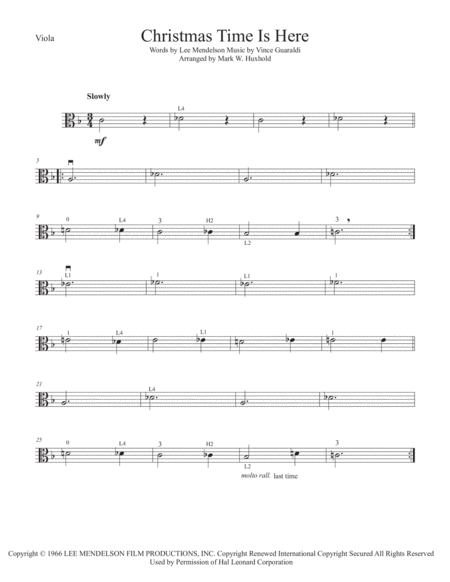Instrumental Duet Instrumental Duet,Viola,Violin - Level 3 - Digital Download
SKU: A0.808440
Composed by Vince Guaraldi. Arranged by Mark W. Huxhold. Jazz. Score and parts. 2 pages. Mark Wayne Music, LLC #3688833. Published by Mark Wayne Music, LLC (A0.808440).
2018 Holiday Contest Entry
Performance Considerations
This arrangement retains the same form and key as the original soundtrack recording and is very flexible. On an ad hoc basis, choir, jazz piano, and/or snare with brushes can easily be added. A lead sheet is also included in the set of parts and is available separately from Mark Wayne Music
Educational Considerations
1. Minimum Proficiency/Curricular Assumption - The student has studied the key of F, but the key of Bb may be currently under study. Fingerings that are unique to the key of Bb are provided as listed by instrument below. Positions are indicated for cello and bass
2. Harmony and Enharmonics - This piece provides an excellent opportunity to discuss how the oddly spelled note illustrates its’ function within the chord. Notes that may be new to the student or enharmonic spellings the player will encounter are listed below. Chord symbols are indicated in the score as an aid.
Violin: L4 on D string, new note Ab
Viola: L4 on G string, new note Db,
Enharmonics- Cb, Fb
Violin III included
Cello: 2 measures extended first position (repeated).
Second position on D string
Bass: New notes: Eb on D string, Db on A string, Ab on E string,
Enharmonic- Gb
Jazz Pizzicato (optional) - Place the inside of the right hand on the string and pluck with the entire side of the index finger, letting it come to rest on the lower string. This has two effects, more sustain, and a more resonant tone. The technique works great for a single bass but may cause an ensemble problem with multiple basses.

Christmas Time Is Here
Violon, Alto (duo) $4.99 4.69 € Violon, Alto (duo) PDF SheetMusicPlus